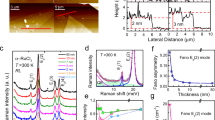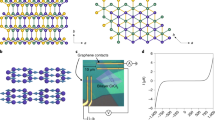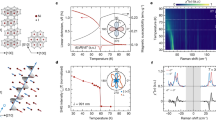Abstract
Layered α-RuCl3 is a promising material to potentially realize the long-sought Kitaev quantum spin liquid with fractionalized excitations. While evidence of this state has been reported under a modest in-plane magnetic field, such behaviour is largely inconsistent with theoretical expectations of spin liquid phases emerging only in out-of-plane fields. These predicted field-induced states have been largely out of reach due to the strong easy-plane anisotropy of bulk crystals, however. We use a combination of tunnelling spectroscopy, magnetotransport, electron diffraction and ab initio calculations to study the layer-dependent magnons, magnetic anisotropy, structure and exchange coupling in atomically thin samples. Due to picoscale distortions, the sign of the average off-diagonal exchange changes in monolayer α-RuCl3, leading to a reversal of spin anisotropy to easy-axis anisotropy, while the Kitaev interaction is concomitantly enhanced. Our work opens the door to the possible exploration of Kitaev physics in the true two-dimensional limit.
This is a preview of subscription content, access via your institution
Access options
Access Nature and 54 other Nature Portfolio journals
Get Nature+, our best-value online-access subscription
$29.99 / 30 days
cancel any time
Subscribe to this journal
Receive 12 print issues and online access
$259.00 per year
only $21.58 per issue
Buy this article
- Purchase on Springer Link
- Instant access to full article PDF
Prices may be subject to local taxes which are calculated during checkout





Similar content being viewed by others
Data availability
All relevant data within the article and supporting information are available from the corresponding authors upon reasonable request.
References
Kitaev, A. Anyons in an exactly solved model and beyond. Ann. Phys. 321, 2–111 (2006).
Patel, N. D. & Trivedi, N. Magnetic field-induced intermediate quantum spin liquid with a spinon Fermi surface. Proc. Natl Acad. Sci. USA 116, 12199–12203 (2019).
Hickey, C. & Trebst, S. Emergence of a field-driven U(1) spin liquid in the Kitaev honeycomb model. Nat. Commun. 10, 530 (2019).
Kaib, D. A. S., Winter, S. M. & Valentí, R. Kitaev honeycomb models in magnetic fields: dynamical response and dual models. Phys. Rev. B 100, 144445 (2019).
Freedman, M. H., Kitaev, A., Larsen, M. J. & Wang, Z. Topological quantum computation. Bull. Am. Math. Soc. 40, 31–38 (2003).
Chaloupka, J., Jackeli, G. & Khaliullin, G. Zigzag magnetic order in the iridium oxide Na2IrO3. Phys. Rev. Lett. 110, 097204 (2013).
Rau, J. G., Lee, E. K. H. & Kee, H. Y. Generic spin model for the honeycomb iridates beyond the Kitaev limit. Phys. Rev. Lett. 112, 077204 (2014).
Winter, S. M., Li, Y., Jeschke, H. O. & Valentí, R. Challenges in design of Kitaev materials: magnetic interactions from competing energy scales. Phys. Rev. B 93, 214431 (2016).
Winter, S. M. et al. Models and materials for generalized Kitaev magnetism. J. Phys. Condens. Matter 29, 493002 (2017).
Plumb, K. W. et al. α–RuCl3: a spin-orbit assisted Mott insulator on a honeycomb lattice. Phys. Rev. B 90, 041112 (2014).
Takagi, H., Takayama, T., Jackeli, G., Khaliullin, G. & Nagler, S. E. Concept and realization of Kitaev quantum spin liquids. Nat. Rev. Phys. 1, 264–280 (2019).
Kasahara, Y. et al. Majorana quantization and half-integer thermal quantum Hall effect in a Kitaev spin liquid. Nature 559, 227–231 (2018).
Yokoi, T. et al. Half-integer quantized anomalous thermal Hall effect in the Kitaev material candidate α-RuCl3. Science 373, 568–572 (2021).
Sandilands, L. J., Tian, Y., Plumb, K. W., Kim, Y. J. & Burch, K. S. Scattering continuum and possible fractionalized excitations in α–RuCl3. Phys. Rev. Lett. 114, 147201 (2015).
Banerjee, A. et al. Neutron scattering in the proximate quantum spin liquid α-RuCl3. Science 356, 1055–1059 (2017).
Yadav, R. et al. Kitaev exchange and field-induced quantum spin-liquid states in honeycomb α-RuCl3. Sci. Rep. 6, 37925 (2016).
Jiang, Y. F., Devereaux, T. P. & Jiang, H. C. Field-induced quantum spin liquid in the Kitaev-Heisenberg model and its relation to α–RuCl3. Phys. Rev. B 100, 165123 (2019).
Chern, L. E., Kaneko, R., Lee, H. Y. & Kim, Y. B. Magnetic field induced competing phases in spin-orbital entangled Kitaev magnets. Phys. Rev. Res. 2, 013014 (2020).
Zhang, S. S., Halász, G. B. & Batista, C. D. Theory of the Kitaev model in a [111] magnetic field. Nat. Commun. 13, 399 (2022).
Li, H. et al. Identification of magnetic interactions and high-field quantum spin liquid in α-RuCl3. Nat. Commun. 12, 4007 (2021).
Modic, K. A. et al. Scale-invariant magnetic anisotropy in RuCl3 at high magnetic fields. Nat. Phys. 17, 240–244 (2020).
Zhou, X.-G. et al. Intermediate quantum spin liquid phase in the Kitaev material α-RuCl3 under high magnetic fields up to 100 T. Preprint at https://arxiv.org/abs/2201.04597 (2022).
Biswas, S., Li, Y., Winter, S. M., Knolle, J. & Valentí, R. Electronic properties of α–RuCl3 in proximity to graphene. Phys. Rev. Lett. 123, 237201 (2019).
Park, S.-Y. et al. Emergence of the isotropic Kitaev honeycomb lattice with two-dimensional Ising universality in α-RuCl3. Preprint at https://arxiv.org/abs/1609.05690 (2016).
Cao, H. B. et al. Low-temperature crystal and magnetic structure of α–RuCl3. Phys. Rev. B 93, 134423 (2016).
Klein, D. R. et al. Probing magnetism in 2D van der Waals crystalline insulators via electron tunneling. Science 360, 1218–1222 (2018).
Kim, H. H. et al. Evolution of interlayer and intralayer magnetism in three atomically thin chromium trihalides. Proc. Natl Acad. Sci. USA 166, 11131–11136 (2019).
Sahasrabudhe, A. et al. High-field quantum disordered state in α–RuCl3 spin flips bound states and a multi-particle continuum. Phys. Rev. B 101, 140410 (2020).
Ponomaryov, A. N. et al. Nature of magnetic excitations in the high-field phase of α–RuCl3. Phys. Rev. Lett. 125, 037202 (2020).
Banerjee, A. et al. Proximate Kitaev quantum spin liquid behaviour in a honeycomb magnet. Nat. Mater. 15, 733–740 (2016).
Ran, K. et al. Spin-wave excitations evidencing the Kitaev interaction in single crystalline α–RuCl3. Phys. Rev. Lett. 118, 107203 (2017).
Wang, Z. et al. Magnetic excitations and continuum of a possibly field-induced quantum spin liquid in α–RuCl3. Phys. Rev. Lett. 119, 227202 (2017).
Wu, L. et al. Field evolution of magnons in α–RuCl3 by high-resolution polarized terahertz spectroscopy. Phys. Rev. B 98, 094425 (2018).
Shi, L. Y. et al. Field-induced magnon excitation and in-gap absorption in the Kitaev candidate RuCl3. Phys. Rev. B 98, 094414 (2018).
Balz, C. et al. Finite field regime for a quantum spin liquid in α–RuCl3. Phys. Rev. B 100, 60405 (2019).
Wulferding, D. et al. Magnon bound states versus anyonic Majorana excitations in the Kitaev honeycomb magnet α-RuCl3. Nat. Commun. 11, 1603 (2020).
Harada, T. et al. Spin-filter tunnel junction with matched Fermi surfaces. Phys. Rev. Lett. 109, 076602 (2012).
Lambe, J. & Jaklevic, R. C. Molecular vibration spectra by inelastic electron tunneling. Phys. Rev. 165, 821–832 (1968).
Li, H. et al. Giant phonon anomalies in the proximate Kitaev quantum spin liquid α-RuCl3. Nat. Commun. 12, 77203 (2021).
Winter, S. M. et al. Breakdown of magnons in a strongly spin-orbital coupled magnet. Nat. Commun. 8, 1152 (2017).
Mermin, N. D. & Wagner, H. Absence of ferromagnetism or antiferromagnetism in one- or two-dimensional isotropic Heisenberg models. Phys. Rev. Lett. 17, 1133–1136 (1966).
Yadav, R., Rachel, S., Hozoi, L., Van Den Brink, J. & Jackeli, G. Strain- and pressure-tuned magnetic interactions in honeycomb Kitaev materials. Phys. Rev. B 98, 121107(R) (2018).
Kaib, D. A. S., Biswas, S., Riedl, K., Winter, S. M. & Valentí, R. Magnetoelastic coupling and effects of uniaxial strain in α–RuCl3 from first principles. Phys. Rev. B 103, L140402 (2021).
Bachus, S. et al. Thermodynamic perspective on field-induced behavior of α–RuCl3. Phys. Rev. Lett. 125, 097203 (2020).
Maksimov, P. A. & Chernyshev, A. L. Rethinking α–RuCl3. Phys. Rev. Res. 2, 033011 (2020).
Wang, Y. et al. Modulation doping via a two-dimensional atomic crystalline acceptor. Nano Lett. 20, 8446–8452 (2020).
Dai, Z. et al. Crystal structure reconstruction in the surface monolayer of the quantum spin liquid candidate α-RuCl3. 2D Mater. 7, 035004 (2020).
Riedl, K., Li, Y., Valentí, R. & Winter, S. M. Ab initio approaches for low-energy spin Hamiltonians. Phys. Status Solidi 256, 1800684 (2019).
Eschrig, H., Richter, M. & Opahle, I. Relativistic solid state calculations. Theor. Comput. Chem. 14, 723–776 (2004).
Sugano, S. Multiplets of Transition-Metal Ions in Crystals (Elsevier, 2012).
Eichstaedt, C. et al. Deriving models for the Kitaev spin-liquid candidate material α–RuCl3 from first principles. Phys. Rev. B 100, 075110 (2019).
Pavarini, E., Koch, E., Vollhardt, D. & Lichtenstein, A. DMFT at 25: Infinite Dimensions (Forschungszentrum Jülich, 2014).
Pedersen, K. S. et al. Iridates from the molecular side. Nat. Commun. 7, 12195 (2016).
Neese, F. Software update: the ORCA program system, version 4.0. Wiley Interdiscip. Rev. Comput. Mol. Sci. 8, e1327 (2018).
Kresse, G. & Hafner, J. Ab initio molecular dynamics for liquid metals. Phys. Rev. B 47, 558–561 (1993).
Grimme, S. Semiempirical GGA-type density functional constructed with a long-range dispersion correction. J. Comput. Chem. 27, 1787–1799 (2006).
Acknowledgements
A.W.T. acknowledges support from the US Army Research Office (W911NF-21-2-0136), Ontario Early Researcher Award (ER17-13-199) and the National Science and Engineering Research Council of Canada (RGPIN-2017-03815). This research was undertaken thanks in part to funding from the Canada First Research Excellence Fund. R. Hovden acknowledges support from the US Army Research Office (W911NF-22-1-0056), S.H.S. and Y.M.G. acknowledge support from the Keck Foundation. S.M.W. was supported by a pilot grant from the Center for Functional Materials, and performed computations on the Wake Forest University DEAC Cluster, a centrally managed resource with support provided in part by Wake Forest University. D.A.S.K., S.B. and R.V. acknowledge support by the Deutsche Forschungsgemeinschaft through grants VA 1171/15-1 and TRR 288-4 22213477 (project A05). G.Y. and R. He are supported by National Science Foundation CAREER grant no. DMR-1760668 and National Science Foundation grant no. DMR-2104036. H.L. acknowledges support by the National Key R&D Program of China (grant no. 2018YFE0202600), the Beijing Natural Science Foundation (grant no. Z200005) and the Fundamental Research Funds for the Central Universities and the Research Funds of Renmin University of China (18XNLG14 and 19XNLG17, respectively).
Author information
Authors and Affiliations
Contributions
B.Y. and A.W.T. conceived and initiated the study. B.Y. fabricated the α-RuCl3 devices for transport measurements, electron diffraction and Raman spectroscopy. B.Y. performed the IETS and lateral transport measurements. S.H.S., Y.M.G. and R. Hovden conducted the three-dimensional electron diffraction measurements. G.Y. and R. He performed the Raman spectroscopy. S.B., D.A.S.K., R.D., R.V. and S.M.W. performed the ab initio calculations. C.L., S.Y. and H.L. grew the α-RuCl3 crystals. F.C. grew the 1 T′-MoTe2 crystals. S.J. conducted the magnetic circular dichroism measurements. B.Y. and A.W.T. wrote the manuscript with the input of all authors.
Corresponding authors
Ethics declarations
Competing interests
The authors declare no competing interests.
Peer review
Peer review information
Nature Materials thanks Hu Miao and the other, anonymous, reviewer(s) for their contribution to the peer review of this work.
Additional information
Publisher’s note Springer Nature remains neutral with regard to jurisdictional claims in published maps and institutional affiliations.
Extended data
Extended Data Fig. 1 IETS device with Gr contacts.
(a): Colorized optical image of the sample. The device is fabricated in the same geometry as shown in Fig. 1a, except the Td-MoTe2 is replaced by few-layer graphene and the thickness of α-RuCl3 is 5-6 layers. (b): False-color two-dimensional plot of background-subtracted d2I/dV2 spectrum taken from 0.3 K to 10 K for positive bias. The trace at 0.3 K is overlaid in blue. The low-energy peak at 1 meV is reproduced in this sample, which gradually disappears above ~8 K, and the continuum between 4-10 meV is reproduced as well.
Extended Data Fig. 2 Temperature-dependent IETS data on few-layer α-RuCl3.
Upper panels: 1L, 2L, and 3L α-RuCl3 spectra with changing temperature from 2 K to 10 K in 1 K increments without background subtraction. Offset is applied for clarity. Grey lines represent the backgrounds for the IETS data. Lower panels: 1L, 2L, and 3L α-RuCl3 spectra with background subtraction. The background-subtracted data is used for plotting Fig. 2.
Extended Data Fig. 3 Temperature dependence of magnetization for a bulk α-RuCl3 single crystal used in the measurements.
The sharp kink near 8 K indicates the Néel temperature, which is consistent with IETS data.
Extended Data Fig. 4 Original field-dependent IETS data without background subtraction.
1L, 2L, and 3L α-RuCl3 spectra without background subtraction with changing B|| (a) and B⊥ (b) from 0 T to 14 T in 1 T increments and offset for clarity.
Extended Data Fig. 5 False-color plot of normalized IETS spectra without background subtraction for 3L α-RuCl3 from 0 T to 14 T.
Evolution of the low-energy magnon peak and the maximum position of the magnon continuum is overlaid in grey and red, respectively.
Extended Data Fig. 6 Magnetic circular dichroism (MCD) measurements comparing 1L α-RuCl3 and 1L CrBr3.
(a): \({{{\mathrm{{\Delta}}}MCD}} = {{{\mathrm{MCD}}}} - {{{\mathrm{MCD}}}}(0{{{\mathrm{T}}}})\) for 1L α-RuCl3 at 3.5 K and 1L CrBr3 at 5 K between ±70 mT. The data for 1L CrBr3 is reproduced from previous work in ref. 27. (b): MCD data for 1L α-RuCl3 at 3.5 K between ± 8 T.
Supplementary information
Supplementary Information
Supplementary Figs. 1–9, Tables 1 and 2 and Sections 1–6.
Rights and permissions
Springer Nature or its licensor (e.g. a society or other partner) holds exclusive rights to this article under a publishing agreement with the author(s) or other rightsholder(s); author self-archiving of the accepted manuscript version of this article is solely governed by the terms of such publishing agreement and applicable law.
About this article
Cite this article
Yang, B., Goh, Y.M., Sung, S.H. et al. Magnetic anisotropy reversal driven by structural symmetry-breaking in monolayer α-RuCl3. Nat. Mater. 22, 50–57 (2023). https://doi.org/10.1038/s41563-022-01401-3
Received:
Accepted:
Published:
Issue Date:
DOI: https://doi.org/10.1038/s41563-022-01401-3
This article is cited by
-
Structural tweaking of 2D quantum magnetism
Nature Materials (2023)



